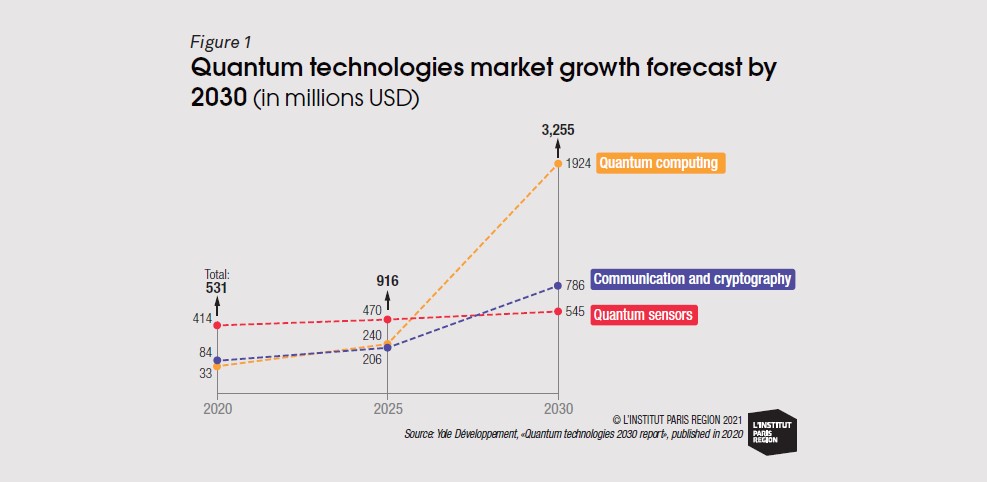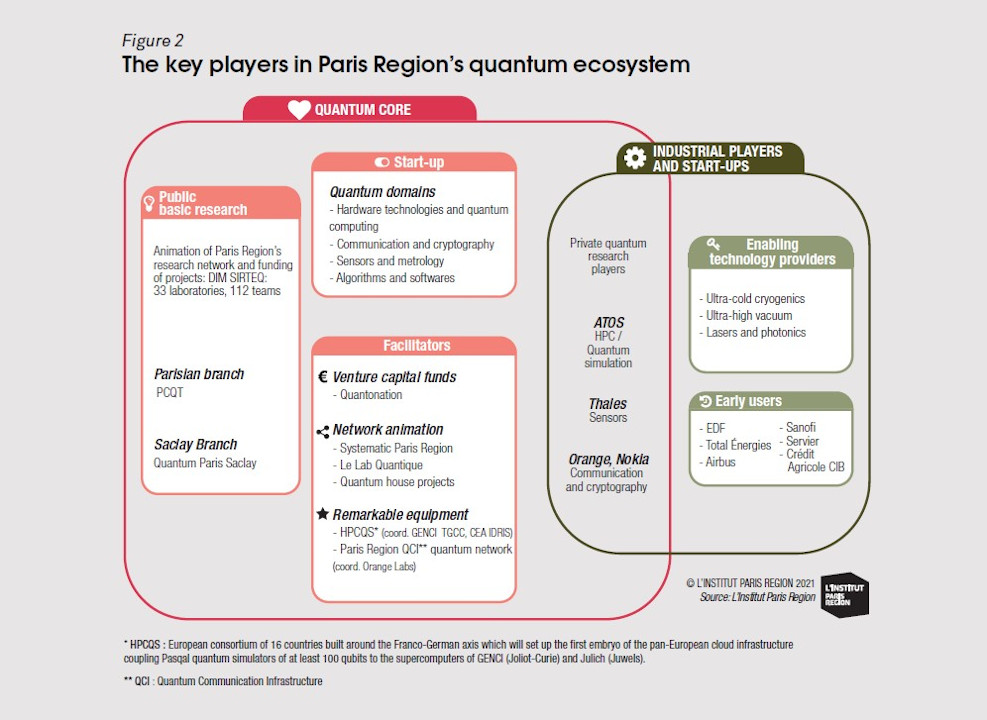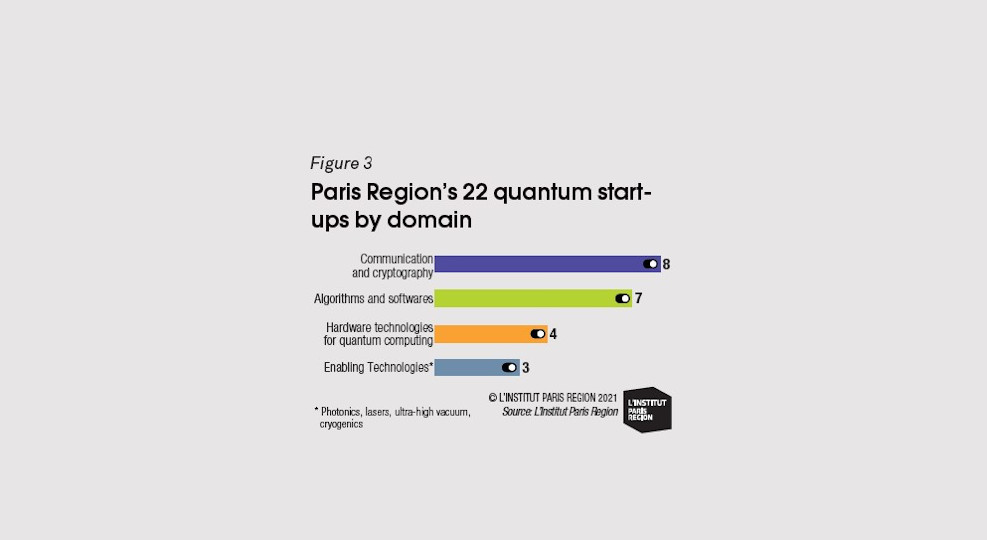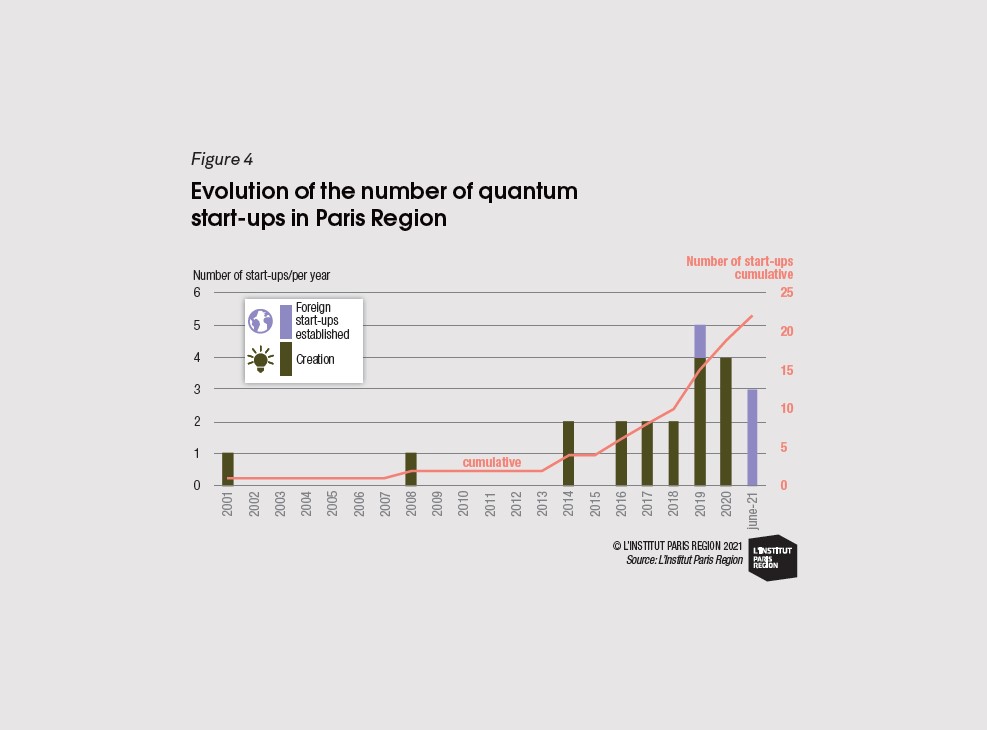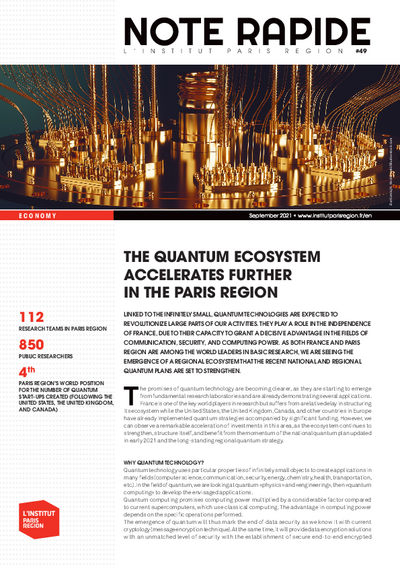The quantum ecosystem accelerates further in the Paris Region
Linked to the infinitely small, quantum technologies are expected to revolutionize large parts of our activities. They play a role in the independence of France, due to their capacity to grant a decisive advantage in the fields of communication, security, and computing power. As both France and Paris Region are among the world leaders in basic research, we are seeing the emergence of a regional ecosystem that the recent national and regional quantum plans are set to strengthen.
The promises of quantum technology are becoming clearer, as they are starting to emerge from fundamental research laboratories and are already demonstrating several applications. France is one of the key world players in research but suffers from a relative delay in structuring its ecosystem while the United States, the United Kingdom, Canada, and other countries in Europe have already implemented quantum strategies accompanied by significant funding. However, we can observe a remarkable acceleration of investments in this area, as the ecosystem continues to strengthen, structure itself, and benefit from the momentum of the national quantum plan updated in early 2021 and the long-standing regional quantum strategy.
WHY QUANTUM TECHNOLOGY?
Quantum technology uses particular properties of infinitely small objects to create applications in many fields (computer science, communication, security, energy, chemistry, health, transportation, etc.). In the field of quantum, we are looking at quantum «physics» and «engineering», then «quantum computing» to develop the envisaged applications. Quantum computing promises computing power multiplied by a considerable factor compared to current supercomputers, which use classical computing. The advantage in computing power depends on the specific operations performed. The emergence of quantum will thus mark the end of data security as we know it with current cryptology (message encryption technique). At the same time, it will provide data encryption solutions with an unmatched level of security with the establishment of secure end-to-end encrypted internet and virtually unbreakable security of communications. The development of a wide range of quantum sensors with increased performance will lead to applications in autonomous navigation, imagery, radars, etc. Quantum will also make it possible to greatly increase the simulation and optimization capabilities of complex systems, even very large, for many applications. Thus, it will allow artificial intelligence to take a step forward, greatly accelerating machine learning. In health, it will facilitate and accelerate the discovery of new molecules, allowing the creation of new drugs, with a better ability to simulate interactions between drug molecules, on the one hand, and with the patient on the other, and at the same time speeding up clinical trials. Some other applications that are currently under evaluation by economic players who are qualified as “early users” include simulation and optimization of energy networks, optimization of complex production management in industry, and fleet management in transport – particularly containers in maritime transport, flight and passenger management in airports, etc. These uses illustrate the strategic nature in the mastery of quantum technology not only to develop new markets and applications but also to maintain sovereignty over data. It is no coincidence that players in the field of defense are among the first to show interest in mastering this technology. Quantum represents a global market that is estimated at around 500 million USD in 2020 and is expected to drastically increase to reach more than 3 billion USD by 2030 according to the market research firm, Yole Développement (see Figure 1).
WHERE DO WE STAND IN THE RESEARCH?
There are several main areas of research and development of quantum technologies.
Quantum computing (hardware)
The specific hardware to make a quantum computer is the subject of numerous research projects all over the world led mainly by players from North America, China, and Europe (particularly the United Kingdom, France, Finland, and Austria). However, the arrival of a universal quantum computer (performing all the tasks of a current computer) is still distant and even impossible for some specialists. Thus, we are exploring many options simultaneously and are currently moving towards hybrid solutions based on quantum modules coupled with conventional High Performance Computers (HPC).
Quantum software
Specialized software to simulate or operate a quantum computer is one of the most advanced areas of quantum research and development. Many global players are positioned in this niche (particularly in North America) and offers are already available with either physical hardware or via the cloud (cloud computing). The French company, Atos, is the European leader in this field.
Quantum sensors
These devices use quantum properties to offer ultra-precise measuring devices such as magnetometers, accelerometers, atomic clocks, etc. This field is the most mature because it calls for more accessible technologies with already many applications and a large market.
Quantum communication
This domain consists of developing a terrestrial and satellite communication network and an internet based on quantum technologies. These communications will benefit from an ultra-enhanced level of security thanks to quantum cryptography technologies and will allow the interconnection of quantum computers. This field is the subject of advanced research on all continents starting with the United States and China but also the European Union and the European space in the broad sense with the United Kingdom and Switzerland.
Quantum cryptography
This field consists of cryptography based on quantum properties, which is strongly associated with quantum communication. Although the quantum computer is not yet a reality, its arrival or the appearance of quantum modules added to supercomputers is likely to revolutionize data encryption. The key players of the field are proposing, on one hand, post-quantum cryptography solutions (using mathematical tools whose decryption would theoretically not be possible even by a quantum computer) and, on the other hand, quantum cryptography solutions (using the physical properties of quantum, thus offering absolute security). We are currently moving towards using a combination of these two techniques to secure communications in the short and long term. The emergence of 5G and the blockchain (technology to store and transmit information without control body) are expected to greatly increase the need for quantum cryptography.
WHERE DOES PARIS REGION STAND WITH QUANTUM TECH?
According to a report conducted by MP Paula Forteza1, Paris Region and the region of Grenoble represent 80% of the French quantum potential, and Paris Region hosts two of the three main poles of excellence in French quantum. At the base of the development of Paris Region’s quantum ecosystem stands the large community of fundamental research structured around the centers of Paris (Paris Center for Quantum Technologies) and Saclay (Quantum Paris Saclay), which are supported by the DIM (major area of interest) SIRTEQ (Paris Region science and engineering for quantum technologies). It consists of 848 public research staff, including 250 full-time equivalent2 researchers who work on this subject in 33 laboratories and their 112 research teams. Among its notable members, there are the CNRS (National center for scientific research), CEA (the Commissariat of atomic energy and alternative energies), INRIA (the national institute of research in computer science and technology), University Paris Saclay, Sorbonne University, University of Paris… The strength of Paris Region’s research and its worldwide recognition lies in the variety of themes addressed (see map).
Start-ups and large corporations
Beyond the research, which remains essential for these still emerging technologies, Paris Region’s quantum ecosystem has emerged and, as of 2021, includes more than 60 private players, 22 start-ups, 24 companies providing “enabling technologies” (necessary for the arrival of the quantum computer), and 14 large corporations (private players in the research of quantum or “early users”) such as Atos (see Figure 2).
Atos, the supplier of high-performance computing equipment and simulation software solutions, is the leading European industrial player in quantum with its Atos Quantum program. Other large corporations, such as Thales (in network security, sensors, and metrology), Orange and Nokia (in communication and cryptography), and even Total Énergies and EDF (in high-performance computing) are carrying out research activities in the field of quantum. The interest brought by these economic players to quantum technologies constitutes another asset for Paris Region’s ecosystem. By carrying out tests with a goal of integrating them into their activity and proposing their use cases, these “early users” accelerate the release of quantum technologies from laboratories and the emergence of start-ups. To promote the involvement of industrialists and support the start-ups within Paris Region’s ecosystem, Paris Region has put in place the PAck Quantique (PAQ) program as of 2020, launched and carried jointly by Genci (the grand national team for high-performance computing) and the Lab Quantique with a financing of 1.5 million euros over the course of 3 years (see inset further below).
Paris Region’s ecosystem also shows its dynamism through the emergence of start-ups which are often spin-offs from public research laboratories. Many of them are leaders in their field. According to Olivier Ezratty’s report and our own estimations, Paris Region in 2021 features 22 start-ups in the field of quantum. The Region is also home to 75% of French quantum start-ups3. This is more than what was identified in all of Germany (13), which puts Paris Region at the 4th place in the world for the creation and hosting of quantum start-ups after the United States, Canada, and the United Kingdom. Among these, we can cite Quandela (proposing a unique single-photon source) and Pasqal (with their future cold atom-based quantum simulator which will be coupled with the Joliot-Curie supercomputer of Genci and the CEA), and the startups, Alice & Bob, LightOn, and C12 Quantum Electronics which are also positioned for the development of the quantum computer (see Figure 3).
The quantum ecosystem also benefits from the presence of key players and strong competences in enabling technologies such as cryogenics (temperatures lower than -150°C), ultra-high vacuum (extreme vacuum level), optics, and lasers. For example, the start-ups, Cryoconcept and Mycryofirm, are specialized in cryogenics. Paris Region’s ecosystem also features older players such as Riber and Agilent Technologies (in ultra-high vacuum), and Ixblue and once again, Riber (in lasers and photonics). There is also Plassys Bestek which specializes in thin films and sensors. Air Liquide took a majority stake in Cryoconcept in 2020, allowing Air Liquide to position itself in the quantum market.
A well-integrated ecosystem
Paris Region’s quantum ecosystem is highly integrated with significant synergies between academic players, those in public research and industry, and start-ups. Participation in numerous joint research projects, whether French or European, reflects these synergies and contributes to their strengthening. Paris Region’s quantum ecosystem also benefits from the actions of various facilitators, whether they come from the world of research or the private sector. On the research side, in addition to DIM SIRTEQ, two structures unite and drive the Parisian ecosystem, with the PCQC (Paris Center for Quantum Computing) and the ecosystem of Saclay, with Quantum Paris Saclay. These local actions aim to continue in relation with national and regional actions. These structures are complemented by the action of the Systematic Paris Region innovation and technology cluster dedicated to deep tech (disruptive technologies), which acts as a facilitator of the entrepreneurial community. In 2018, the private start-up fund, Quantonation, was created. This fund is the only one in its category in Europe specifically dedicated to quantum technologies and deep tech, undeniably reinforcing this momentum. Now, with a fund of 20 million euros, it contributes to the capital of 12 start-ups, including 3 which were created in Paris Region and 2 foreign start-ups which have come to establish themselves in the Region. To complete this overview, the Lab Quantique contributes to the vitality of the French quantum community. Other strengths of the Region include the presence of two high-performance computing centers in Essonne: TGCC (Très Grand Centre de Calcul) in Bruyères-le-Châtel, and Idris (the Institute for Development and Resources in Intensive Scientific Computing) in Orsay, where you can find the Genci supercomputers operated by the CEA and the CNRS respectively. These two machines have classical multi-PetaFlops calculation capacities (unit of measurements of quantity for numerical calculations) dedicated to French and European open academic and industrial research. In the framework of the national quantum strategy, the Joliot-Curie supercomputer, hosted at the TGCC, will offer HPC/quantum hybrid computation simulation services via its coupling to the Fresnel simulator from the start-up, Pasqal.
A SHARP ACCELERATION SINCE 2019
Paris Region’s ecosystem is experiencing a phase of acceleration and internationalization with the creation of 12 start-ups between 2017 and 2020. In 2021, 3 foreign start-ups have joined Paris Region’s quantum ecosystem with the support of Choose Paris Region: KETS Quantum Security (United Kingdom), PQShield (United Kingdom), and Multiverse Computing (Spain) join QCWare, the American start-up that came to the Region in September 2019. Other international projects are currently under consideration. This internationalization proves Paris Region’s attractiveness in the field of quantum, which offers many perspectives thanks to these foreign start-ups’ participation in the collaborative projects and the presence of early-stage users such as Orange, EDF, Airbus, Total Énergies, Sanofi, Servier, and more recently, Crédit Agricole CIB, who request their services in order to test solutions (see Figure 4).
A NATIONAL AND REGIONAL QUANTUM PLAN
Paris Region’s quantum ecosystem is already involved in the European Quantum Flagship, a project with a budget of 1 billion euros that is intended to finance collaborative research projects. The Region’s quantum ecosystem will further benefit from two recent announcements. Since January 2021, the national quantum plan offers 1.8 billion euros (an amount similar to the British, German, and American plans). The Regional action in favor of quantum will dedicate 3 million euros (in line with the Region’s investment of 12 million euros in the DIM SIRTEQ) to finance research projects and quantum infrastructures in Paris Region in order to consolidate the ecosystem and attract new players. Other projects are being studied such as the creation of one or two “Quantum houses,” totem places intended to embody the Paris Region quantum ecosystem by hosting conferences, mentoring sessions, start-ups, and potentially, industrialists in order to promote synergies. Paris Region’s quantum ecosystem is at the beginning of a promising trend which will still require significant support for fundamental research. In addition, the animation of the ecosystem remains an important issue, particularly through collaborative research projects but also projects around use cases likely to attract new players. Finally, the big challenge for this community is to avoid territorial and national competition, especially at the European level (mainly with Germany, which remains the only other main competitor since Brexit). This collaboration at all levels is necessary to be able to weigh in against substantial ecosystems (with the US and China in the lead) endowed with very significant resources. Europe is the only scale at which it will be possible to build sovereignty in the quantum domain.■
1. «Quantique le virage technologique que la France ne ratera pas», parliamentary report written by MP Paula Forteza, January 2020.
2. This is an estimation based on incomplete data.
3. According to Olivier Ezratty’s report, there were 25 quantum start-ups in France in September 2020. At this time, according to our estimates, there were 19 in the Paris Region, being 75%. «Comprendre l’informatique quantique», Olivier Ezratty, September 2020.
THE NATIONAL STRATEGY FOR QUANTUM TECHNOLOGIES
The French quantum plan announced in January 2021 has a budget of 1.8 billion euros over 5 years. It aims above all to fund quantum research in all its components. It will also support programs of technological maturation, industrial development, and the growth of start-ups. It also promotes the development of dedicated training and the industrial transfer.
REGIONAL ACTIONS IN QUANTUM MATTER
The DIM SIRTEQ, with a budget of 12 million euros over the course of 4 years (2017-2021), played a pioneering role to federate and organize the Region’s academic research and notably spark the emergence of start-ups. Paris Region has subsequently supported several other actions, with more ambition for the economic development, a budget of more than 3 million euros. The PAck Quantique (PAQ) finances the implementation of quantum technologies issued by the Region’s start-ups in order to demonstrate, if possible, a quantum advantage. In 2020, three proofs of concept were launched, notably involving the start-ups Pasqal and Qubit Pharmaceuticals as well as Total Énergies and EDF. The project Paris Region QCI (Quantum Communication Infrastructure), coordinated by Orange, aims to deploy a quantum communication network between Saclay, Châtillon, and Paris to test secure communication solutions. Finally, the Region has provided its support for the Quarbone project and the C12 start-up to design a quantum accelerator founded on carbon nanotubes.
This study is linked to the following theme :
Economy
